On Lincoln-Shinola, Euro EV Sales, Engineered Carbon, and more
On a Lincoln-Shinola concept, Euro EV sales, engineered carbon for fuel cells, a thermal sensor for ADAS, battery analytics, and measuring vehicle performance in use with big data
#economics
This week On Automotive
- Past, Present and. . . .: The Lincoln Aviator Shinola concept
- Over There: Euro EV Sales
- Fuel Cells & the Importance of Engineered Carbon
- Saving Lives with a Sensor
- A Three-Letter Acronym EV Developers Need to Know
- And while of the subject of data analysis. . .: The Cost of Vehicle Ownership
///
Past, Present and. . . .

Lincoln, meet Shinola. (Image: Lincoln)
“Founded in 2011, our company operates an in-house watch and leather factory on the fifth floor of the historic Argonaut Building, where a team of artisans hand assembles luxury timepieces and crafts premium leather straps.” That, from the Shinola Detroit website.
The 11-storey Argonaut Building, designed by Albert Kahn, was opened in 1928, as the General Motors Research Laboratory.
And while on the subject of history. . .
Henry Leland established Cadillac in 1902 in Detroit, based on the assets of the defunct Henry Ford Company. (Henry’s second company. His third company was the charm.)
Leland sold Cadillac to GM in 1909, left the company in 1917. . .and established the Lincoln Motor Company the same year.
In 1922 Lincoln was purchased by the Ford Motor Company.
Which brings us back to Shinola.
Kemal Curic, design director, Lincoln: “Shinola opened up their showroom to us as a playground – allowing us to explore how their brand’s lifestyle ethos could be woven into a new theme for one of our vehicles. Our designers were handed a rare gift, and they made the most of it.”
Lincoln and Shinola designers collaborated on the Lincoln Aviator Shinola concept.
The SUV features:
- A white exterior that references the mother of pearl stone watch dials of the Shinola watches
- Copper accents that are inspired by the copper-plated structure on the seat of a Shinola Runwell bike seat
- A woven textile sewn into the seats that resemble the Shinola brand stripe
- Woven metal mesh on the IP that glosses a Shinola watch band
History doesn’t repeat itself. But it does resonate.
Especially in Detroit.
///
Over There
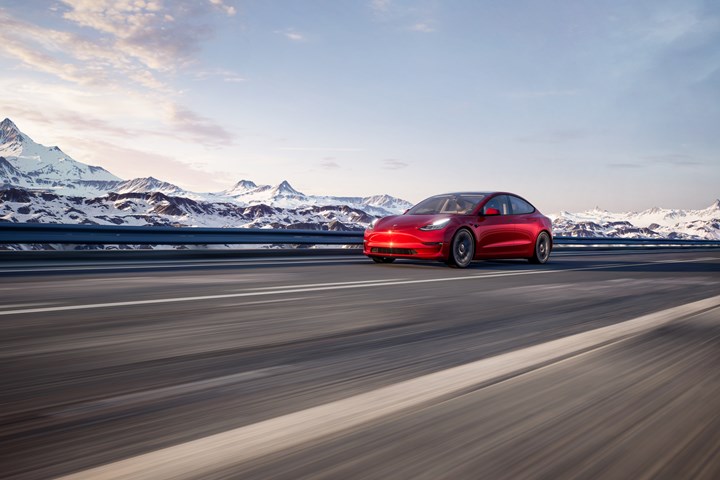
Yes, cars from an American company can do quite well in Europe, as the Tesla Model 3 shows. (Image: Tesla)
Back in 1997, John F. Smith, then Cadillac general manager, made a presentation at the Frankfurt Motor Show.
He stated that Cadillac, with the ’98 Seville, would be making a serious run at the European market.
I was at that press conference. The Europeans surrounding me seemed. . .puzzled.
Since then:
- Smith retired from GM in 2010. (He left Cadillac in 1999.)
- The Seville went out of production in 2004.
- GM sold its European business in 2017.
- (The IAA held its last Frankfurt Motor Show in 2019. It is moving it to Munich for this year’s event.)
The point is that U.S. manufacturers have long tried to make it big in Europe.
It rarely works out.
(One could argue that Ford has been successful, but given that it setup shop in Europe in 1909, it is pretty much an indigenous company.)
But then there is Tesla.
Of course.
According to EV market analyst Matthias Schmidt of Schmidt Automotive Research, during the first half of 2021 Tesla sold 65,976 Model 3s in western Europe.
Volkswagen, which arguably has home-field advantage, came in second in EV sales, with 30,292 ID.3s sold.
Even adding in the 4th place VW ID.4’s 24,204 units puts the German company at a 11,480-unit deficit to the Tesla Model 3.
Perhaps even more surprising: according to JATO Dynamics, the Tesla Model 3 was the second-best selling vehicle in Europe in June—EV or otherwise. It had sales of 25,697 units.
VW was in first place with the Golf, at 27,247.
That’s a delta of 1,550 units.
Seems that the right product can get it done.
///
Fuel Cells & the Importance of Engineered Carbon
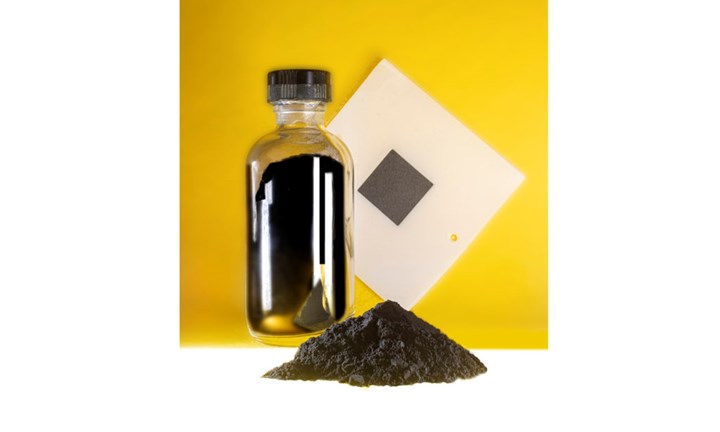
That’s not just your run-of-the-mill carbon. (Image: Pajarito Powder)
Call it a “coincidence of credibility.”
On August 4, while at the Center for Automotive Research Management Briefing Seminars, I had the opportunity to sit down with Thomas J. Stephenson, CEO & chairman, of Pajarito Powder.
Stephenson wanted to talk about powder, the powder that Pajarito produces.
A mesoporous carbon material.
He had a bottle of it similar to the one in the photo. There was also a coupon with a black square like the one in the photo.
“Did you hear that we received a Series B investment from Hyundai today?” Stephenson asked me.
I hadn’t.
But it made talking about a specially processed carbon powder all the more interesting because one of the world’s leading automakers put proverbial skin in the game.
What is Hyundai’s interest in this?
It is pursuing fuel cells. There is the Nexo SUV it introduced in the fall of 2018 that launched with a 95-kW fuel cell and a 40-kW battery that are used to power a 120-kW motor and provide a range of 380 miles.
And probably more important is the Class 8 heavy duty truck that it has developed using its XCIENT Fuel Cell, which it started operating in Switzerland last year (more than one-million km have been clocked) and which it will begin testing in California in Q2 2023. There will be 30 big rigs involved.
Back to the powder and the coupon.
Stephenson says that one of the issues with hydrogen for vehicles is the fact that precious metals are required for the fuel cells. In the Nexo, for example, he says there are some 57 grams of platinum.
What Pajarito is doing is providing a carbon powder (a.k.a., “advanced catalyst support materials” or “interconnected mesoporous carbon”) specifically engineered such that the amount of precious metals in a given fuel cell system can be reduced. The coupon is an example of the material coated on a Gore-Tex-like material that is part of the fuel cell stack.
Stephenson points out, “Platinum doesn’t scale.”
So by using this engineered powder for the membrane electrode assembly, the dispersion of the precious metals can be done such that less is required because the performance of a given surface area is improved by up to 2X.
Webb Johnson, Pajarito senior director of Business Development, cites some numbers from a Department of Energy presentation circa 2019 that shows that scale can drive the costs down for fuel cells:
Current estimate:
Fuel Cell System: $210/kW
Hydrogen Storage: $21/kWh
100,000 units per year estimate:
Fuel Cell System: $50/kW
Hydrogen Storage: $17/kWh
500,000 units per year estimate:
Fuel Cell System: $45/kW
Hydrogen Storage: $8/kWh
So, he explains, a 100-kW fuel cell system at 500,000 units per year would cost $4,500 per unit. Then, with a hydrogen onboard storage system of 167 kWh, which he says is the size of the capacity on a Toyota Mirai, it would be $1,336.
The total per vehicle: $6,636.
In terms of what the Pajarito powder can mean at scale is a reduction of the cost of a fuel cell stack—at high volume—by some 40%.
However. . .
There is a consideration of the application.
“Anybody can build a fuel cell that lasts 15 minutes,” Stephenson says.
But for a car, where the number might be 4,000 hours or a truck when it is 20,000 hours, that’s a different thing, entirely.
Which gets to the point of the importance of engineering the carbon for the application.
Fun Fact
Well, not fun if it happens to you.
According to Johnson, “Turning a car on and off”—drive to work; drive home; drive to the store; etc.—“tends to break down a fuel cell more than anything else. The carbon breaks down and the platinum goes out the tailpipe with the water.”
Yes, engineered material is important.
///
Saving Lives with a Sensor
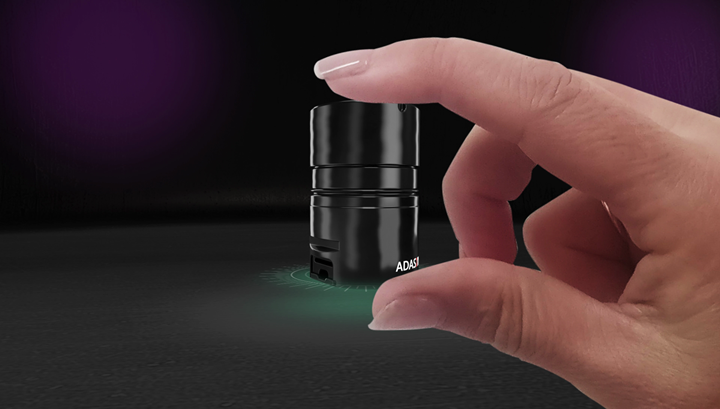
Adasky thermal sensor: small but immensely capable. (Image: Adasky)
The U.S. pedestrian fatality rate per billion vehicle miles traveled increased 21% in 2020 compared to 2019, according to the Governors Highway Safety Association.
Think about that: 2020, the COVID year, when parents were working from home and their kids were learning there, too, saw an increase in deaths from traffic fatalities.
On a global basis, according to the World Health Organization, approximately 1.3-million people die each year as a result of road traffic crashes.
Yakov Shaharabani, CEO of Adasky, says that’s completely unacceptable.
And he thinks that his company has a technology that can greatly reduce the number of deaths when it is implemented in an ADAS system.
It is thermal imaging technology.
In terms of implementation it is a high-resolution, long-range infrared (LWIR) shutterless thermal camera, a solid-state device about the size of a tube of Revlon Super Lustrous lipstick (or, technically, 2.6 cm diameter; 4.3 cm long) that is mounted on the exterior of a vehicle (it must be open to the air as it is measuring temperature) that works with an AI system that the company has developed.
Although some might think of this as “night vision,” it works in direct sunlight, as well as at night.
It has a range of >200 meters.
It measures temperature in increments of 0.05° C.
Subjective:
I was in a vehicle equipped with a system that displayed the images being captured on the screen of a laptop. It was a bright, sunny day. It was like watching a high-definition black & white TV. Even the leaves on trees were discernable. The AI system identified people and moving vehicles even when the vehicle was facing the sun.
Technical:
Asked about temperature differentiation of various objects, the word from Adasky in response to my query:
The radiation emitted from any object is proportional to the fourth power of the object’s temperature. See the Stefan–Boltzmann law.
The driving scene contains a rich and dynamic collection of objects, where the temperature of each object is directly affected by the environment as well as its own unique characteristics.
Thus, both vehicles and especially living objects like people and animals "glow" against the surrounding environment (i.e, the road itself, the air, and other objects in the scenery).
For this reason, despite the environmental complexities of the driving scene, ADASKY's thermal detection capabilities generate very detailed and clear images.
Implementation:
Shaharabani says that a U.S. automaker will be implementing the company’s Viper system in 2023 models.
///
A Three-Letter Acronym EV Developers Need to Know
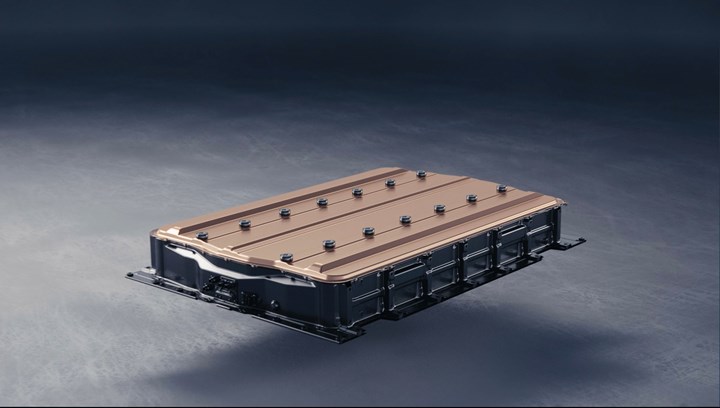
Developing, engineering, manufacturing and using EV batteries involves plenty of data. (Shown here is a Ultium battery from General Motors)
“We started off calling it ‘battery intelligence.’ Then we realized we needed a three-letter acronym,” says Eli Leland, chief technology officer and co-founder of Voltaiq. “So we call it ‘enterprise battery intelligence.’”
EBI.
On the subject of batteries, Tal Sholklapper, CEO and co-founder of the company that was founded nine years ago in Berkeley, California, points out that for the auto industry these are still early days: “There is no commodity battery that you can buy off the shelf.”
What’s more, “This technology is relatively fickle. It is unlike other components in modern devices, which are either mechanical or semiconductor-based.” Both well understood.
“Batteries are like living beings.”
Which he explains by saying that they are sensitive to temperatures, to how they were built (a slight misalignment of a component can make one battery behave differently from one without it), to age and to other factors.
Leland chimes in, “You could be pulling the same amount of energy out of battery A and battery B, both which were built on the same line. But one might discharge with a slightly lower voltage than the other, which means that a battery management system has to be engineered to accommodate that variation to make sure that you don’t over charger or discharge a cell during a cycle, because if you do it over and over again, that cell will fail faster and have a cascading effect that can cause the entire pack to fail.”
A Rumsfeld Moment
Sholklapper: “The head of battery engineering at one of the car companies described it to me as ‘unknown unknowns.’”
The two explain that there is an immense amount of data that is generated in the development, manufacturing and use phases of batteries. It is being collected. But for a variety of reasons—one of which is probably the volume of data—it isn’t being utilized as it could be by the OEMs.
It is known to be there. But the contents are unknown. (Generally speaking.)
Which is where Voltaiq comes in.
Essentially it is a software as a service (SaaS) product that collects information from all stages of a lifecycle including R&D, production and use. This information is harmonized into a common format for ready accessibility.
So it is possible to get information about a battery such that it is simpler to see what makes a better battery (or not).
Sholklapper: “We’re looking at everything from qualifying new chemistries and suppliers to validating warranty and performance on new cells, integration into battery packs, installation into vehicles, and the battery lifecycle.”
How complicated is this?
Sholklapper says when Voltaiq first pitched Microsoft and Google on its EBI system, they were told that there were sufficient software teams at each of the companies to do it themselves. Both—as well as Mercedes-Benz R&D North America, Proterra and Joby Aviation—are now customers.
How important is this?
Sholklapper and Leland use Apple and Tesla as examples of the importance of EBI as a practice. Apple introduced the iPod some 20 years ago, which started, as they put it, the transformation of the firm into “a battery-based company.” Tesla has “from day one”—nearly 20 years ago (2003) “understood the value of data and analytics.”
Obviously both companies did what they did long before Voltaiq existed. Both companies, they suggest, have made doing the overall analysis of batteries a priority.
But now that Voltaiq’s system does exist, it seems like the sort of thing battery development teams at companies where this has heretofore not been much of an issue would like to leverage.
///
And while of the subject of data analysis. . .
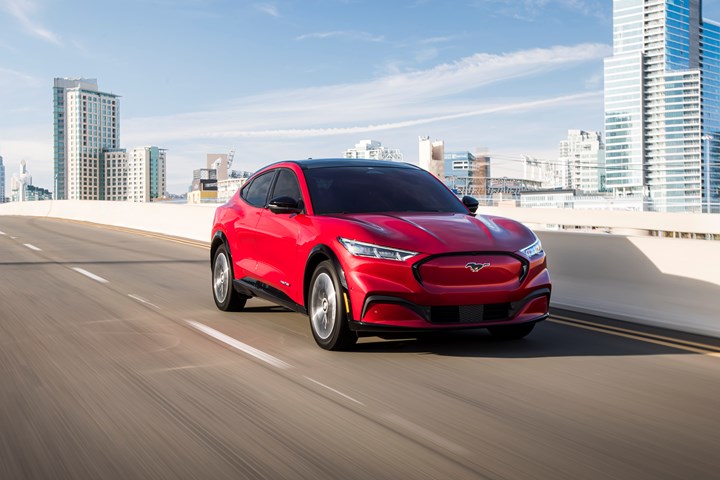
The Mustang Mach-E had an extremely good launch according to We Predict stats. (Image: Ford)
With more than 28 years at GM dealing primarily with quality data, then 3.5 years at J.D. Power as vp of U.S. Automotive Quality, Renee Stephens knows more than a little something about topics ranging from product development to warranty—and lots in between.
Now she’s the vp of Competitive Quality Benchmarking at We Predict, a company that utilizes machine learning and big data obtained from dealerships and service centers—about 20% of all of them in the U.S.—to get an actual assessment of the costs associated with vehicles and components.
(You bring your vehicle in. Information including the complaint, the cause, the correction, the parts, the tech’s time, etc. are collected and sent to We Predict, where it undergoes analysis.)
Big. And Bigger.
Stephens notes from her time at GM, “teardowns were a big deal” for product development.
But she points out that this was generally a count of one, because it was expensive to acquire a vehicle for disassembly.
This system has tens of thousands of vehicles in its database.
A bigger deal.
About that EV. . .
Stephens says that they’ve been looking at the costs associated with owning an EV over three months, then a year.
While the maintenance cost of an EV is half that of a gas-powered vehicle after three months, the repair cost is two times higher and the campaign (a.k.a. recall) cost four times higher.
After a year, the maintenance costs are 77% less for the EV, and while there is a slight improvement in the repair cost—only 1.7 times higher rather than 2x—the campaign costs are still 4 times higher than for a gasoline vehicle.
Why? Stephens emphasizes that for EVs this is “an industry in launch.”
- So the average diagnosis hours for an EV after the first year are 2x higher than gas.
- The average diagnosis rate is 1.2x higher than gas.
- The average labor hours are 1.5x higher.
- And the average labor rate is 1.3x higher than gas.
But with time, she says, that will change.
While of the subject of launch:
We Predict looked at the cost per vehicle of four different cars during the first three months of ownership and found:
- Ford Mustang Mach-E: $93
- Audi e-tron: $366
- Porsche Taycan: $667
- Jaguar I-Pace: $834
Ford clearly had a good launch.
RELATED CONTENT
-
Aluminum Sheet for EV Battery Enclosure
As the number of electric vehicles (EVs) is about to increase almost exponentially, aluminum supplier Novelis is preparing to provide customers with protective solutions
-
On The Jeep Grand Cherokee, 2022 Nissan Pathfinder, and More
An inside look at the Detroit Assembly Complex-Mack; a innovative approach to waste-free, two-tone painting; why a forging press is like an F1 car; and other automotive developments.
-
on lots of electric trucks. . .Grand Highlander. . .atomically analyzing additive. . .geometric designs. . .Dodge Hornet. . .
EVs slowdown. . .Ram’s latest in electricity. . .the Grand Highlander is. . .additive at the atomic level. . .advanced—and retro—designs. . .the Dodge Hornet. . .Rimac in reverse. . .


.jpg;width=70;height=70;mode=crop)






